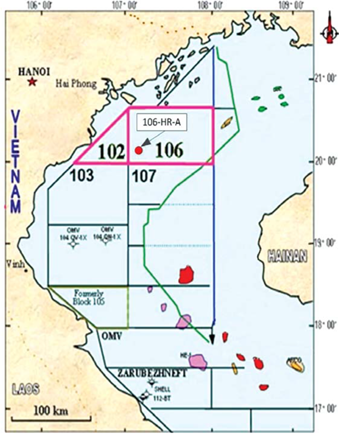Petrophysical characterisation of pore system for a carbonate reservoir in the HR structure
Tóm tắt
The purpose of reservoir characterisation is to fi gure out the spatial distribution of petrophysical properties such as porosity, permeability and water saturation that are key parameters for construction of the geological model. Characterisation of a carbonate reservoir is often diffi cult mainly due to the complexity of its pore system. This study presents an integrated approach to using well log and micro-geological data to characterise rock fabrics and their pore system for a carbonate reservoir in the HR structure. Based on well log data such as GR, PE, PHIN and RHOB, two major rock types of dolostone and limestone were identifi ed. A further combination with thin section and SEM analysis results indicated four types of carbonate rock fabric, namely limestone with grain-dominated grainstone, limestone with grain-dominated packstone, dolostone with grain-dominated grainstone and dolostone with grain-dominated packstone. For each identifi ed carbonate fabric, two types of pore were found, including interparticle and vuggy pores. The latter can be further subdivided into separate-vug pores and touching-vug pores. For the HR structure, the touching vug porosity and the interparticle porosity were estimated to be in the range of 1 - 3% and 1 - 8%, respectively. The inter-crystalline porosity, which might be considered as a subset of the interparticle porosity and could be estimated by SEM analysis, was found in the range from 1,5% to 3%. It is expected that the integrated analysis approach using well log and micro-geological data employed in this study can be applied to evaluate the characteristics of carbonate reservoirs at other well sites in Song Hong basin.
Các tài liệu tham khảo
Petrovietnam. Investment opportunity in Block 102/10 & 106/10. www.pvn.vn.
L.A.Lubis, Zuhar Zahir Harith. Pore type classification on carbonate reservoir in off shore sarawak using rock physics model and rock digital images. IOP Conference Series Earth and Environmental Science. 2013.
F.J.Lucia. Rock fabric/petrophysical classification of carbonate pore space for reservoir characterization. AAPG Bulletin. 1995; 79(9): p. 1275 - 1300.
F.J.Lucia. Carbonate reservoir characterization: An integrated approach (2nd edition). New York: Springer. 2007.
L.H.Nielsen, A.Mathiesen, T.Bidstrup, O.V.Vejbæk, P.T.Dien, P.V.Tiem. Modelling of hydrocarbon generation in the Cenozoic Song Hong basin, Vietnam: A highly prospective basin. Journal of Asian Earth Sciences. 1999; 17(1 - 2): p.269 - 294.
K.Al-Atroshi, Tan Ching Kiang, Armi Amdan.Analytical review of Ham Rong geology and geophysics data. First EAGE South-East Asia Regional Geology Workshop -Workshop on Palaeozoic Limestones of South-East Asia and South China. 5 December, 2011.
E.R.Crain. Crain’s petrophysical handbook. 2014.
J.A.Burke, R.L.Campell Jr, A.W.Schmidt. The litho porosity cross plot: A new concept for determining porosity and lithology from logging methods. SPWLA 10th Annual Logging Symposium, Houston, Texas, US. 25 - 28 May, 1969.
John H.Doveton. Principle of mathematical petrophysics. Oxford University Press. 2014. 10. Schlumberger. Log interpretation principles/applications. 1989.
Felix Chayes. Petrographic modal analysis: An elementary statistical appraisal. John Wiley & Sons Inc.1956.
The National Institute of Health (NIH). ImageJ manual press. 2015.
F.J.Lucia. Petrophysical parameters estimated from visual descriptions of carbonate rocks: A field classification of carbonate pore space. Journal of Petroleum Technology.1983; 35(3): p. 629 - 637.
Philip W.Choquette, Lloyd C.Pray. Geologic nomenclature and classification of porosity in sedimentary carbonates. AAPG Bulletin. 1970; 54(2): p. 207 - 250. 15. Volodymyr Kindratenko. Development and application of image analysis techniques for identification and classification of microscopic particles. Illinois University. 1997.

1. Tác giả giao bản quyền bài viết (tác phẩm) cho Tạp chí Dầu khí, bao gồm quyền xuất bản, tái bản, bán và phân phối toàn bộ hoặc một phần tác phẩm trong các ấn bản điện tử và in của Tạp chí Dầu khí.
2. Bằng cách chuyển nhượng bản quyền này cho Tạp chí Dầu khí, việc sao chép, đăng hoặc sử dụng một phần hay toàn bộ tác phẩm nào của Tạp chí Dầu khí trên bất kỳ phương tiện nào phải trích dẫn đầy đủ, phù hợp về hình thức và nội dung như sau: tiêu đề của bài viết, tên tác giả, tên tạp chí, tập, số, năm, chủ sở hữu bản quyền theo quy định, số DOI. Liên kết đến bài viết cuối cùng được công bố trên trang web của Tạp chí Dầu khí được khuyến khích.




